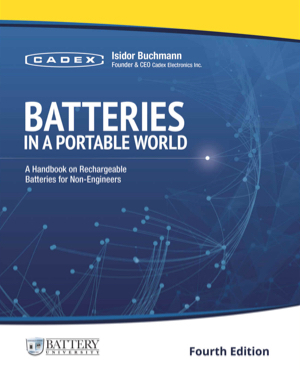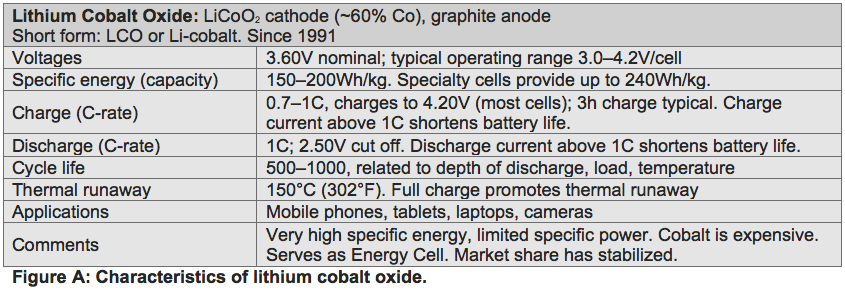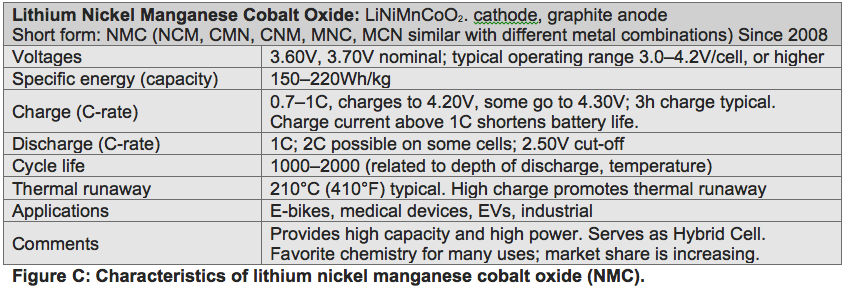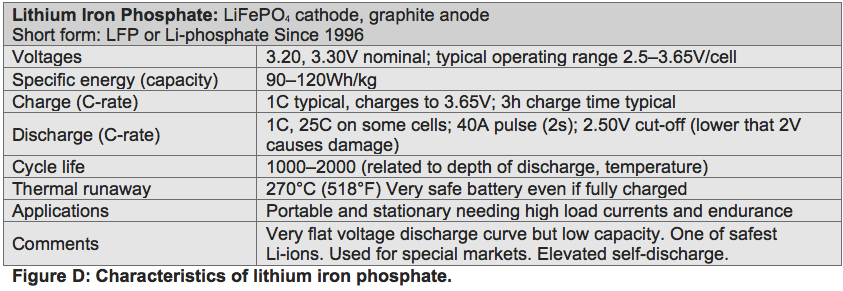Topic 4: Battery Attribute and Safety Summary Tables
Another way to portray these different types of lithium batteries is by summarizing what seems to be known about the different chemical combinations with lithium. From a safety perspective, the “Thermal Runaway” characteristic noted below is of particular importance.
Sony, the maker of the lithium-ion cells in question, points out that on rare occasion microscopic metal particles may come into contact with other parts of the battery cell, leading to a short circuit within the cell.
Battery manufacturers strive to minimize the presence of such particles; however, complex assembly techniques make the elimination of all metallic dust a challenge. Cells with ultra-thin separators of 24µm or less (24-thousandth of an mm) are more susceptible to impurities than the older designs with lower Ah ratings. Whereas the 1,350mAh cell in the 18650 package could tolerate a nail penetration test, the high-density 3,400mAh can ignite when performing the same test. (See BU-306: What is the Function of the Separator?) New safety standards direct how batteries are used, and the UL1642 Underwriters Laboratories (UL) test no longer mandates nail penetration for safety acceptance of lithium-based batteries.
The building blocks of a battery are the cathode and anode, and these two electrodes are isolated by a separator. The separator is moistened with electrolyte and forms a catalyst that promotes the movement of ions from cathode to anode on charge and in reverse on discharge. Ions are atoms that have lost or gained electrons and have become electrically charged. Although ions pass freely between the electrodes, the separator is an isolator with no electrical conductivity.
The small amount of current that may pass through the separator is self-discharge and this is present in all batteries to varying degrees. Self-discharge eventually depletes the charge of a battery during prolonged storage. Figure 1 illustrates the building block of a lithium-ion cell with the separator and ion flow between the electrodes.

BATTERY SEPARATORS – IMPORTANT DETERMINANT OF Failure
Battery separators provide a barrier between the anode (negative) and the cathode (positive) while enabling the exchange of lithium ions from one side to the other.
Early batteries were flooded, including lead acid and nickel-cadmium. With the development of the sealed nickel-cadmium in 1947 and the maintenance-free lead acid in the 1970s, the electrolyte is absorbed into a porous separator that is compressed against the electrodes to achieve chemical reaction. The tightly wound or stacked separator/electrode arrangement forms a solid mechanical unit that offers similar performance to the flooded type but is smaller and can be installed in any orientation without leakage. The gases created during charge are absorbed and there is no water loss if venting can be prevented.
Early separators were made of rubber, glass fiber mat, cellulose and polyethylene plastic. Wood was the original choice but it deteriorated in the electrolyte. Nickel-based batteries use separators of porous polyolefin films, nylon or cellophane. The absorbed glass mat (AGM) in the sealed lead acid version uses a glass fiber mat as a separator that is soaked in sulfuric acid.
The earlier gelled lead acid developed in the 1970s converts the liquid electrolyte into a semi-stiff paste by mixing the sulfuric acid with a silica-gelling agent. Gel and AGM batteries have slight differences in performance; gel batteries are commonly used in UPS and AGM in starter and deep-cycle applications. (See BU-201: How does the Lead Acid Battery Work?)
Commercially available Li-ion cells use polyolefin as a separator. This material has excellent mechanical properties, good chemical stability and is low-cost. A polyolefin is a class of polymer that is produced from olefin by polymerizing olefin ethylene. Ethylene comes from a petrochemical source; polyolefin is made from polyethylene, polypropylene or laminates of both materials.
The Li-ion separator must be permeable and the pore size ranges from 30 to 100nm. (Nm stands for nano-meter, 10-9, which is one millionth of a millimeter or about 10 atoms thick.) The recommended porosity is 30–50 percent. This holds enough liquid electrolyte and enables the pores to close should the cell overheat.
Separator Serves as Fuse in Li-ion
On excessive heat, a shut-down occurs by closing the pores of the Li-ion separator through a melting process. The polyethylene (PE) separator melts when the core reaches 130°C (266°F). This stops the transport of ions, effectively shutting the cell down. Without this provision, heat in the failing cell could rise to the thermal runaway threshold and vent with flame. This internal safety fuse also helps pass the stringent UN Transportation Testing for Lithium Batteries that includes altitude simulation, as well as thermal, vibration, shock, external short circuit, impact, overcharge and forced discharge tests. (See BU-304a: Safety Concerns with Li-ion.)
Most batteries for mobile phones and tablets have a single polyethylene separator. Since ca. 2000, larger industrial batteries deploy a trilayered separator that provides enhanced fuse protection on thermal extremes and on multi-cell configurations. Figure 2 illustrates the PP/PE/PP trilayer separator consisting of polyethylene in the middle that is sandwiched by outer polypropylene (PP) layers. While the inner PE layer shuts down at 130°C by closing the pores, the outer PP layers stay solid and do not melt until reaching 155°C (311°F).

Combining separator material with different melting properties adds to safety. PE melts before PP to close the pores and stop current flow.
In ca. 2008, further improvements were made by adding a ceramic-coated separator. Ceramic particles do not melt and this addition provides a further safety level. Ceramic coating is also used on lithium cobalt oxide (LCO) cells that charge up to 4.40V/cell instead of the traditional 4.20V/cell. The ceramic coating works in tandem with the PE and PP layers and is placed next to the positive side to prevent electrical contact.
The separator should be as thin as possible so as to not add dead volume and still provide sufficient tensile strength to prevent stretching during the winding process and offer good stability throughout life. The pores must be uniformly spread on the sheet to ensure even distribution throughout the entire separator area. Furthermore, the separator must be compatible with the electrolyte and allow easy wetting. Dry areas can create hot spots through elevated resistance, leading to cell failure.
Separators are getting thinner. A thickness of 25.4μm (1.0 mil) is common but some go down to 20μm, 16μm and now even 12μm without significantly compromising the properties of the cell. (One micron, also known as µm, is one millionth of a meter.) The separator with electrolyte in modern Li-ion only makes up 3 percent of the cell content.
Ultrathin separators raise safety concerns. The massive Sony call-back comes to mind in which a one-in-200,000 cell-breakdown triggered an almost six million recall of Li-ion packs. On rare occasions, microscopic metal particles came into contact with other parts of the battery cell, which led to an electrical short circuit. The Sony cells in question had a separator thickness of between 20µm and 25µm. (A micrometer (µm) is one-thousands of a millimeter.) Some separators are as thin as 10 µm. Micro-shorts on separators examined in forensic labs measure about a millimeter in diameter. A well-designed separator melts at the point of shorting and provides a local shutdown.
References
[1] Source: CELGARD, LLC
[2] Source: Dalhousie, Handbook of Batteries






